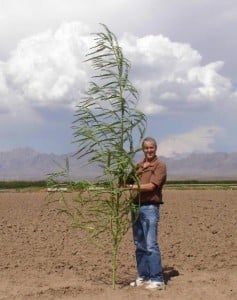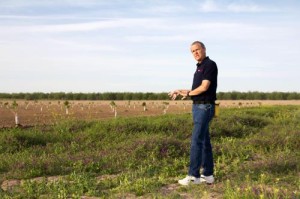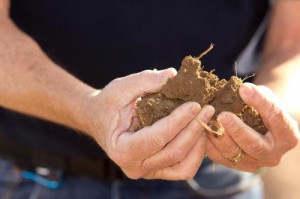
Date: 07/08/2014
Writer: Emily C. Kelley, 575-646-1957, [email protected]
A New Mexico State University scientist’s work in carbon sequestration is turning heads – not just here in New Mexico, but also in Austria and Australia. His work suggests a potential solution for dealing with the carbon dioxide-related problems that seem to be causing global warming.
There are nearly seven billion people on Earth with a collective carbon footprint from energy usage of more than 30.5 billion tons of carbon dioxide per year. If reducing this footprint will return the planet to more moderate climatic conditions, experts say we need a safe and inexpensive system to efficiently capture carbon dioxide from ambient air and safely store it, with few negative impacts on the economy or environment and no long-term liabilities for storage.
David C. Johnson, NMSU research scientist and molecular biologist at WERC, a consortium for environmental education and technology development housed in the College of Engineering, does research for the Institute of Sustainable Agricultural Research at NMSU.
Johnson’s research in carbon capture and storage in agricultural soils was recently highlighted in a book called “The Soil Will Save Us,” by Kristin Ohlson.

“We have plenty of issues in both our climate and in agriculture,” Johnson said. “What this research pursued is how to best capture that CO2 and get it back in the soil, while also improving our agricultural systems. It turns out that our farmers are ‘the key’ to successfully reducing greenhouse gases within a sustainable agricultural system.”
The work started in 2004 when Johnson had a project with the United States Department of Agriculture, trying to solve the problem of what to do with cow manure from dairy cows. The USDA wanted a product that would sell and also would be good for agriculture, so Johnson developed a composting process that basically reduced the salinity of the manure, but also created a compost that yielded a reduced salinity that was good for the soil, but most importantly, it contained a diverse microbial community structure.

“Most composting is done in windrows, turning it each day or every other day, which disrupts fungal growth,” Johnson said. “The process we developed was a no-turn process, so you didn’t disrupt the fungal community, allowing it to thrive. What we noticed while growing plants in this compost is what focused us onto how to change soil, and how to move the soil microbial population from a bacterial to fungal-dominated community.”
Johnson had a microbial community structure analysis done on the compost. There were microbes first discovered in different places around the world, in the Arctic and Antarctic, along with pelagic bacteria from the ocean, and there were intestinal bacteria, as well. This diversity of microbes ended up in a compost that used only materials originating from the Las Cruces area.
What is it that makes Johnson’s compost so unique?
“It’s not so much making the compost, but it was the change in plant growth we observed when we shifted the soil microbial community structure, moving it from bacterial-dominated to fungal,” Johnson said. “That’s what we’re now trying to do in agriculture – trying to shift the microbial community structure in soils.”
This isn’t accomplished by applying compost, as that is not practical for the large acreages agricultural producers manage. Instead, the Institute of Sustainable Agricultural Research is trying to implement this change by growing it into the soil.
“This is basically how soils evolve – different plants will come in and grow, and they’ll have a certain influence on that soil, as far as being able to increase the carbon content. That seems to be the key here,” Johnson said. “The carbon plants capture using the CO2 in the atmosphere is an energy substrate. Soil organisms, like our society, depend on energy. As you add more energy into the system, you increase population density. A little more energy, you change the population structure, diversity develops and you begin to get specializations. When you achieve sufficient energy resources, you start to notice mutualisms between plants and soil microbes.”
Studies at the Institute of Sustainable Agricultural Research indicate increased soil organic matter in agricultural ecosystems promotes improved plant growth, soil water-holding capacity, increased macro- and micro-nutrient availability, reduced system energy requirements and reduced land preparation and cultivation costs.
“Soils with higher carbon content and larger fungal populations enabled us to double the production in the soil with the same amount of water,” Johnson said. “Once you improve your soils to the point they have a higher carbon content and a better soil microbial structure, then, if you can grow twice the amount of food on half the amount of land, you can reduce the amount of land you farm, and in doing this, you can cut your water usage. Agriculture currently uses about 80 percent of our freshwater resources.”
Managing soil in this manner, many of the decisions are made for you, as the microbes and the plants have worked together for 5.5 million years and have developed a biological barter system, trading nutrients for energy. Johnson says we can develop these systems in agricultural soils, however, many traditional agricultural management processes block them, or stop them, or remove a key player in the process.
“I’m trying to bring all the players back in and let them do what they do best for capturing carbon and improving soil fertility. This will have such an impact on agriculture as far as being able to grow plants better, with less input, less water and cutting back on the downstream pollution we see from all of the fertilizers we apply to the soils,” Johnson said. “It will change the way we approach agriculture. And, my waste product from reducing atmospheric CO2 concentrations is food. Can you beat that?”
Watch this video on YouTube at http://youtu.be/7Q0z890zT9I.
For more information on this, and other NMSU stories, visit the NMSU News Center.
Excellent blog post. I absolutely love this
site. Keep it up!